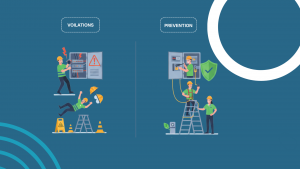Thinking about how to start an HVAC business or already running one and want to grow? Having a clear plan is the difference between struggling and building a strong, profitable business. That’s why we put together this HVAC business checklist—so you know exactly what steps to take, what tools you need, and how to avoid common mistakes.
Why Planning Matters in the HVAC Business
Starting an HVAC business isn’t just about fixing air conditioners or heaters. It’s also about building trust, managing money, and running a smooth operation. Without a plan, even skilled technicians can struggle to grow. A clear plan helps you stay organized, avoid legal or financial issues, and focus on long-term success.
Business Planning and Legal Setup
- Registering Your Business and Choosing the Right Structure – Decide if you’ll run as a sole proprietorship, partnership, LLC, or corporation. Register your business name and get the right paperwork in place.
- Licensing and Certifications Required for HVAC Contractors – Most states require licenses to operate legally. You’ll also need industry certifications like EPA Section 608 and many others. These not only keep you compliant but also make customers trust you more.
- Insurance and Compliance Requirements – Get general liability insurance, worker’s compensation, and vehicle insurance. This protects you, your team, and your customers.
Financial Planning
- Estimating Startup Costs and Budgeting – Plan for vans, tools, equipment, software, marketing, insurance, and payroll. Having a budget keeps you from overspending.
- Pricing Strategy for Services – Set fair and competitive pricing. Don’t undercharge just to get customers—you need to cover your costs and still make profit.
- Setting Up Accounting and Bookkeeping Systems – Use accounting software to track expenses, invoices, and payroll. This makes tax season easier and helps you see your cash flow clearly.
Operational Setup
- Tools, Equipment, and Inventory Management – Invest in quality tools, vans, and safety gear. Keep a system to track parts and supplies so you don’t run out during jobs.
- Choosing the Right HVAC Software for Scheduling & Invoicing – HVAC management software makes scheduling jobs, sending invoices, and tracking customers much easier.
- Standard Operating Procedures (SOPs) for Efficiency – Write down step-by-step processes for common tasks. This ensures every job is done consistently and saves time training new employees.
Building Your Team
- Hiring Skilled Technicians and Office Staff – Hire licensed technicians and reliable office staff to handle scheduling and calls. The right people make your business run smoothly.
- Training and Continuous Skill Development – Offer ongoing training to keep your team updated on the latest HVAC technology and best practices.
- Employee Safety and Compliance Training – Train your team on safety standards and OSHA requirements to avoid accidents and penalties.
Marketing and Branding Essentials
- Creating a Strong Brand Identity – Pick a business name, logo, and professional look that customers will remember.
- Website and Online Presence Setup – Build a professional website that shows your services, service areas, and contact info.
- Local SEO, Google Business Profile, and Reviews – Claim your Google Business Profile, ask customers for reviews, and make sure your business shows up when people search “HVAC near me.”
- Advertising (PPC, Social Media, Flyers, Partnerships) – Use paid ads, social media, and flyers to attract customers. Build partnerships with local businesses for referrals.
(Tip: Joining HVAC associations like SNARSCA helps you network and grow faster.)
Customer-Centric Checklist
- Providing Excellent Customer Service – Show up on time, be professional, and explain repairs clearly. Good service brings repeat customers.
- Creating Maintenance Contracts & Loyalty Programs – Offer annual maintenance contracts so customers stick with you. Loyalty programs encourage repeat business.
- Handling Complaints and Building Trust – Listen to customers, solve problems quickly, and turn complaints into opportunities to show reliability.
Technology and Innovation
- Smart HVAC Tools and Energy-Efficient Solutions – Stay updated on smart thermostats and eco-friendly systems—customers love energy-saving options.
- Using CRM and Customer Management Tools – A CRM system helps track customers, service history, and follow-ups.
- Staying Ahead with Industry Trends – Keep learning about new HVAC technology and solutions to stay competitive.
Scaling and Growth Planning
- Expanding Service Areas or Specializations – As your business grows, consider adding new services like duct cleaning, refrigeration, or commercial HVAC.
- Networking with Builders, Realtors, and Trade Associations – Work with homebuilders, realtors, and join local HVAC networking events to get more business.
- Tracking KPIs and Business Performance Metrics – Measure your success by tracking leads, jobs completed, revenue, and customer satisfaction.
Final HVAC Business Checklist at a Glance
- Register your business and get licensed
- Secure insurance and stay compliant
- Plan your finances and pricing
- Set up tools, equipment, and software
- Hire and train the right team
- Build your brand and market online
- Put customers first with great service
- Stay updated with technology and trends
- Network and track performance
- Tips for Long-Term Success
Running an HVAC business is not a one-time setup—it’s about constantly improving, building strong relationships, and staying ahead of competitors. With this checklist, you’ll have a clear path to launch, manage, and grow your business with confidence.
Ready to grow your network? Check out SNARSCA membership and upcoming events.


